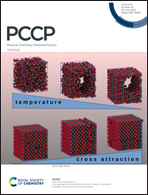An ab initio study on the electronic excited states and photodissociation mechanism of bromocarbene molecule†
Abstract
We used the internally contracted explicitly correlated multireference configuration interaction (icMRCI-F12) method combined with Davidson correction to conduct a high-precision ab initio study of CHBr. The spin–orbit coupling (SOC) is incorporated into the calculation. The 21 spin-free states split into 53 spin-coupled states of CHBr. The vertical transition energies and oscillator strengths are obtained of these states. The SOC effect on the equilibrium structures and the harmonic vibrational frequencies of the ground state X1A′, the lowest triplet state a3A′′ and the first excited singlet state A1A′′ is investigated. The results reveal a significant effect of the SOC on the bond angle and the frequency of the bending mode of a3A′′. The potential energy curves of electronic states of CHBr as functions of the H–C–Br bond angle, C–H bond length, and C–Br bond length, respectively, are also investigated. Based on the calculated results, the interactions between electronic states and photodissociation mechanism involved in CHBr in the ultraviolet region are explored. Our theoretical studies will shed light on the complicated interactions and dynamics of the electronic states of bromocarbenes.



 Please wait while we load your content...
Please wait while we load your content...